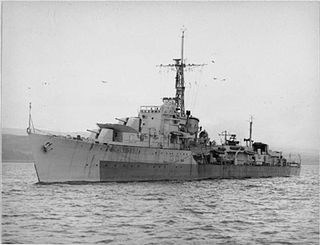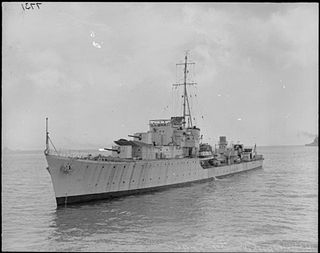
HMAS Quadrant (G11/D11/F01), named for the navigational instrument, was a Q-class destroyer operated by the Royal Navy as HMS Quadrant (G67/D17) during World War II, and the Royal Australian Navy (RAN) from 1945 to 1957. The ship was built during the early 1940s as one of the War Emergency Programme destroyers, and entered service in 1942.

The QF 4.5 inch gun has been the standard medium-calibre naval gun used by the Royal Navy as a medium-range weapon capable of use against surface, aircraft and shore bombardment targets since 1938. This article covers the early 45-calibre family of guns up to the 1970s. For the later unrelated 55-calibre Royal Navy gun, see 4.5 inch Mark 8 naval gun.

HMS Zulu was a Tribal-class destroyer of the Royal Navy and the second ship to bear the name. Built in Glasgow by Alexander Stephen and Sons, her keel was laid down on 10 August 1936, she was launched on 23 September 1937 and commissioned on 7 September 1938.

The Weapon class was a class of destroyers built for the British Royal Navy towards the end of World War II. They were the smaller counterpart to the Battle class and were the first new destroyer designs for the Royal Navy since the Second World War Emergency Programme. 20 ships were planned, of which only 13 were laid down and 7 were launched, but the cessation of hostilities resulted in only 4 being completed for service. Two of the ships had been previously ordered as part of the planned C class, or 15th Emergency flotilla, of 1944, but the orders were changed to the new design.

The W and Z class was a class of sixteen destroyers of the Royal Navy launched in 1943–1944. They were constructed as two flotillas, with names beginning with "W-" and "Z-", respectively, although, like the preceding U and V class, two of the flotilla leaders were named after historical naval figures. They were known as the 9th and 10th Emergency Flotilla, respectively and served as fleet and convoy escorts in World War II. None were lost during World War II but INS Eilat was sunk during the Israel-Egypt conflict in October 1967 by Egyptian missile boats and the El Qaher of the Egyptian Navy was sunk at Berenice, Egypt on 16 May 1970 by Israeli Air Force aircraft during the War of Attrition.

The S and T class was a class of sixteen destroyers of the Royal Navy launched in 1942–1943. They were built as two flotillas, known as the 5th and 6th Emergency Flotilla, and they served as fleet and convoy escorts in World War II.

The Q and R class was a class of sixteen War Emergency Programme destroyers ordered for the British Royal Navy in 1940 as the 3rd and 4th Emergency Flotilla. They served as convoy escorts during World War II. Three Q-class ships were transferred to the Royal Australian Navy upon completion, with two further ships being handed over in 1945. Roebuck had the dubious honour of being launched prematurely by an air raid at Scotts shipyard in Greenock, her partially complete hulk lying submerged in the dockyard for nine months before it was salvaged and completed.

The O and P class was a class of destroyers of the British Royal Navy. Ordered in 1939, they were the first ships in the War Emergency Programme, also known as the 1st and 2nd Emergency Flotilla, respectively. They served as convoy escorts in World War II, and some were subsequently converted to fast second-rate anti-submarine frigates in the 1950s.

The C class was a class of 32 destroyers of the Royal Navy that were launched from 1943 to 1945. The class was built in four flotillas of 8 vessels, the "Ca", "Ch", "Co" and "Cr" groups or sub-classes, ordered as the 11th, 12th, 13th and 14th Emergency Flotillas respectively. The sub-class names are derived from the initial 2 letters of the member ships' names, although the "Ca" class were originally ordered with a heterogeneous mix of traditional destroyer names. A fifth flotilla, the "Ce" or 15th Emergency Flotilla, was planned but were cancelled in favour of the Weapon-class destroyers after only the first two ships had been ordered. The pennant numbers were all altered from "R" superior to "D" superior at the close of World War II; this involved some renumbering to avoid duplications.

The Type 15 frigate was a class of British anti-submarine frigates of the Royal Navy. They were conversions based on the hulls of World War II-era destroyers built to the standard War Emergency Programme "utility" design.

The Type 16 frigates were a class of British anti-submarine frigates of the Royal Navy. They were based on the hulls of World War II-era destroyers that had been rendered obsolete by rapid advances in technology. They were similar in concept to the Type 15 frigate, but were a far more limited design rendered necessary by budget constraints.

The J, K and N class consisted of 24 destroyers built for the Royal Navy beginning in 1938. They were a return to a smaller vessel, with a heavier torpedo armament, after the Tribal class that emphasised guns over torpedoes. The ships were built in three flotillas or groups, each consisting of eight ships with names beginning with "J", "K" and "N". The flag superior of the pennant numbers changed from "F" to "G" in 1940.

HMS Punjabi was a Tribal-class destroyer of the Royal Navy that saw service in the Second World War, being sunk in a collision with the battleship King George V. She has been the only ship of the Royal Navy to bear the name "Punjabi" which, in common with the other ships of the Tribal class, was named after various ethnic groups of the world, mainly those of the British Empire.
At the start of World War II, the Royal Navy operated a range of destroyer classes. Some of these were legacies of World War I, some were designed during the inter-war years and the rest were the result of wartime experience and conditions. British-built and -designed vessels were also supplied to and built by allied navies, primarily the Australian and Canadian navies.

HMS Nubian was a Tribal-class destroyer of the Royal Navy that saw much distinguished service in World War II. She won 13 battle honours, a record only exceeded by one other ship, and matched by two others.

HMS Somali was a Tribal-class destroyer of the British Royal Navy that saw service in World War II. She was launched in 1937, captured the first prize of World War II and served in Home and Mediterranean waters. She was torpedoed on 20 September 1942 in the Arctic and foundered five days later while under tow.

HMS Bedouin was a Tribal-class destroyer of the British Royal Navy that saw service in World War II.

HMS Undaunted was a U-class destroyer of the British Royal Navy that saw service during World War II. She was later converted into a Type 15 fast anti-submarine frigate, with the new pennant number F53.

HMS Undine was a U-class destroyer of the British Royal Navy that saw service during World War II. On 27 March 1945, HMS Undine detached from RN Fast Carrier TF57 to rescue the airmen of a downed RN TBF Avenger aircraft also rescued a USN Corsair pilot adrift for two days south of the Sakishima Gunto in the Philippine Sea.

The second HMS Whirlwind was a W-class destroyer of the British Royal Navy and was built by Hawthorn Leslie and was launched on 30 August 1943. She saw service during World War II and the Cold War.


















